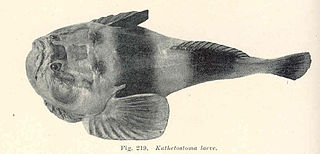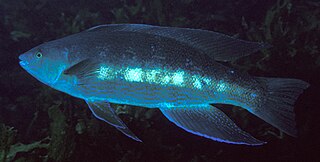
The Percidae are a family of ray-finned fish, part of the order Perciformes, which are found in fresh and brackish waters of the Northern Hemisphere. The majority are Nearctic, but there are also Palearctic species. The family contains more than 200 species in 11 genera. The perches and their relatives are in this family; well-known species include the walleye, sauger, ruffe, and three species of perch. However, small fish known as darters are also a part of this family.

Threadfins are silvery grey perciform fish of the family Polynemidae. Found in tropical to subtropical waters throughout the world, the threadfin family contains eight genera and about 40 species. An unrelated species sometimes known by the name threadfin, Alectis indicus, is properly the Indian threadfish.

The stargazers are a family, Uranoscopidae, of perciform fish that have eyes on top of their heads. The family includes about 51 species in eight genera, all marine and found worldwide in shallow and deep saltwaters.

The Carangidae are a family of ray-finned fish that includes the jacks, pompanos, jack mackerels, runners, trevallies, and scads. It is the largest of the six families included within the order Carangiformes. Some authorities classify it as the only family within that order but molecular and anatomical studies indicate that there is a close relationship between this family and the five former Perciform families which make up the Carangiformes.

The Odacidae are a small family of ray-finned fishes commonly known as cales and weed whitings, formerly classified within the order Perciformes. They are related to the much larger families of the wrasses and parrotfish. More recent workers have classified this family within the order Labriformes, alongside the wrasses and parrotfishes, within the clade Percomorpha.

Stichaeidae, the pricklebacks or shannies, are a family of marine ray-finned fishes in the suborder Zoarcoidei of the order Scorpaeniformes. Most species are found in the North Pacific Ocean with a few in the North Atlantic Ocean.

The Ariidae or ariid catfish are a family of catfish that mainly live in marine waters with many freshwater and brackish water species. They are found worldwide in tropical to warm temperate zones. The family includes about 143 species.

Scardinius is a genus of ray-finned fish in the family Cyprinidae commonly called rudds. Locally, the name "rudd" without any further qualifiers is also used for individual species, particularly the common rudd. The rudd can be distinguished from the very similar roach by way of the rudd's upturned mouth, allowing it to pick food items such as aquatic insects from the surface of the water with minimal disturbance.

Zaniolepis, the combfishes, is a genus of marine ray-finned fish, it is one of two genera in the family Zaniolepididae. These fishes are native to the eastern Pacific Ocean. Z. frenata that was a source of food to the Native American inhabitants of San Nicolas Island off the coast of southern California, United States during the Middle Holocene.

Bryconops is a genus of freshwater fish in the family Iguanodectidae from South America. It consists of small fish, all under half-a-foot long, with slender bodies and silvery scales, though there is some mild color variation. Several species can be identified by way of a humeral patch, and others have a reddish ocellus, or eyespot, on one or both lobes of the dorsal fin.

Cryptacanthodes is a genus of is a genus of marine ray-finned fishes belonging to the monogeneric family Cryptacanthodidae, commonly referred to as wrymouths. Three of the four species are found in the Pacific Ocean with one species native to the western Atlantic Ocean where they are benthic fishes, tunneling through soft substrates. It is currently the only known genus in its family.

Clinocottus is a genus of marine ray-finned fishes belonging to the family Cottidae, the typical sculpins. They are nearshore benthic fishes native to the northeastern Pacific Ocean. They are mentioned as sharpnose sculpins.

Agonomalus is a genus of poachers native to the Pacific Ocean.

Nautichthys is a genus of marine ray-finned fishes, sculpins, belonging to the subfamily Hemitripterinae which is part of the family Agonidae. These fishes are found in the North Pacific Ocean.

Zaniolepis latipinnis, the longspine combfish or longspined greenling, is a species of ray-finned fish belonging to the family Zaniolepididae.The species occurs in the eastern Pacific Ocean.

Chaetodipterus is a genus of marine ray-finned fishes belonging to the family Ephippidae, the spadefishes. These fishes are found in the Atlantic and eastern Pacific Oceans.

Haemulinae is a subfamily of the Haemulidae and consists of the genera of that family which are regarded as being of New World origin, although they are now widespread. The subfamily is distinguished from the Plectorhynchinae by having a short dorsal fin which contains 13-16 soft rays, as opposed to the long dorsal fin with 17-26 soft rays of the subfamily Plectorhynchinae.

Iguanodectidae is a family of freshwater fish in the order Characiformes that lives in South America. It is home to the subfamily Iguanodectinae and the monotypic Bryconops clade. Several species in the family, such as the green line lizard tetra, the tailspot tetra, and the orangefin tetra, are sometimes taken as aquarium fish.

Bryconops alburnoides is a small freshwater fish, approximately 6 inches long at its largest, that lives in the rivers of South America. It has a slender body, with a yellowish dorsal fin and yellow-tinged back scales that fade into silver on its belly. It is largely an insectivore that picks land-dwelling insects from the riverbanks, though it eats much more whenever rain washes prey into the water.
Xiphisterinae is a subfamily of marine ray-finned fishes, classified within the family Stichaeidae, the pricklebacks or shannies. These fishes are found in the North Pacific Ocean.
















